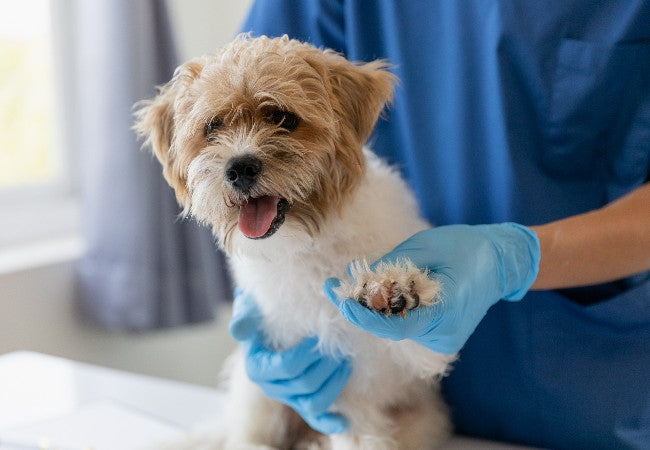Vet’s 2025 Guide to Aortic Thromboembolism in Dogs – Causes, Diagnosis & Care 🐾

In this article
Vet’s 2025 Guide to Aortic Thromboembolism in Dogs – Causes, Diagnosis & Care 🐾
By Dr. Duncan Houston BVSc
💡 What Is Aortic Thromboembolism?
Aortic thromboembolism (also called saddle thrombus) occurs when a blood clot (thrombus or embolus) lodges at the terminal aorta—often at the bifurcation supplying the hind limbs—causing severe blood-flow blockage to pelvic limbs and possibly other organs. Rare in dogs compared to cats, but often extremely painful and serious.
⚠️ Who’s at Risk & Why?
- Underlying diseases: hyperadrenocorticism (Cushing’s), diabetes mellitus, hypothyroidism, protein‑losing nephropathy/enteropathy, heart disease (endocarditis, cardiomyopathy), sepsis, neoplasia, immune‑mediated disorders, pancreatitis, parasitism, trauma.
- Breed predisposition: Greyhounds, Soft‑Coated Wheaten Terriers, Cavalier King Charles Spaniels, Miniature Schnauzers.
- Age & sex: most common in middle‑aged to older dogs; males slightly more affected.
🎯 Clinical Signs
- Acute: sudden hind-limb paralysis or weakness, severe pain, vocalization, cold pale limbs, absent femoral pulses, hypothermia.
- Chronic: exercise intolerance, lameness, muscle wasting, variable pulses.
- Optional: abdominal pain, vomiting, collapse, respiratory distress from concurrent disease.
🔬 Diagnostics
- Physical exam: check femoral pulses, limb temperature, tone, and abdominal pain.
- Blood work: CBC, chemistry (e.g., CK, AST), urinalysis (UPC), clotting tests (PT/aPTT, D-dimer, fibrinogen).
- Ultrasound & Doppler: visualize thrombus at the aortic bifurcation with absent blood flow in iliac vessels. Images above show Doppler and CT angiography of aortic thrombus.
- X-rays/CT/MRI: help assess thrombus, underlying pathology, organ involvement.
💊 Treatment & Urgent Care
- Hospitalization: pain relief, oxygen, intravenous fluids, temperature stabilization.
- Thrombolytics: e.g., streptokinase in early cases; high complication risk (reperfusion injury).
- Anticoagulants & antiplatelets: heparin, aspirin, clopidogrel, possibly warfarin—with careful monitoring.
- Surgery or thrombectomy: mechanical or surgical removal in select cases – some success reported.
- Treatment of underlying cause: e.g., endocrine disease, infection, neoplasia, etc. to prevent recurrence.
🏡 Prognosis & Follow‑Up
- Prognosis is guarded: median survival spans days to several months; a minority live longer.
- Chronic cases may stabilize with consistent management of disease and clot prevention.
- Regular follow-up: recheck limb pulses, imaging of thrombus resolution, blood work, and underlying disease monitoring every 1–3 months.
🛡️ Prevention & Risk Reduction
- Screen and manage risk factors—PCV, endocrine diseases, and protein loss conditions.
- Consider prophylactic antithrombotics in high-risk dogs (with vet guidance).
- Routine wellness exams with pulse palpation and basic clotting evaluations in predisposed breeds.
📲 Owner Resources & Support Tools
- Ask A Vet: Telehealth helps for urgent management, treatment planning, and follow-up care.
🌟 Case Snapshot
Case: “Jack,” a 13‑year‑old Jack Russell with new-onset hind limb dragging and absent pulses in one leg, was diagnosed via ultrasound with a saddle thrombus secondary to newly diagnosed diabetes. Treated with hospitalization, pain control, heparin, clopidogrel, and managed endocrine disease. At 3‑month follow-up, pulses returned, thrombus reduced on ultrasound, and Jack remains walking on all four paws. 🐾
✅ Key Takeaways
- Aortic thromboembolism in dogs is rare but often serious, presenting with sudden limb paralysis, pain, and pulse loss.
- Emergency diagnosis includes physical exam, imaging, Doppler ultrasound, and lab work.
- Treatment combines pain relief, clot dissolution, anticoagulation, and sometimes surgery, but recurrence is common.
- Prognosis is guarded—long-term survival depends on underlying disease control and early intervention.
- Ask A Vet and supportive tools can significantly aid in acute management and long-term wellness 🩺🐶
📥 Need Emergency Help?
If your dog suddenly can't use its back legs or is in pain, seek immediate vet care. For real-time vet support and guidance on treatment options, download the Ask A Vet app or visit AskAVet.com. We're here 24/7 to help. 🐾






